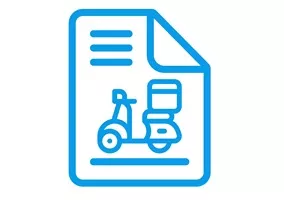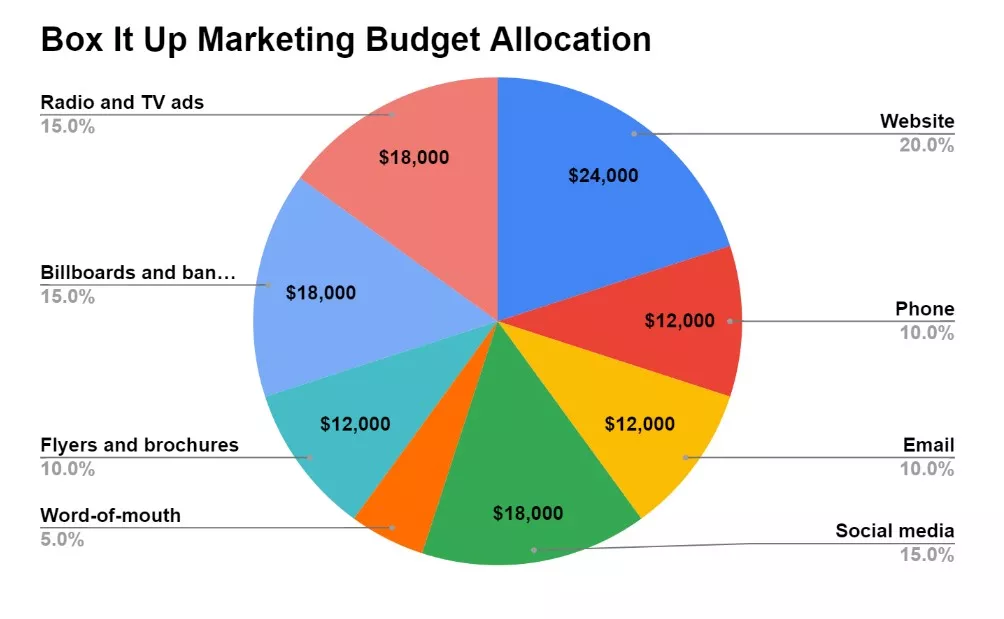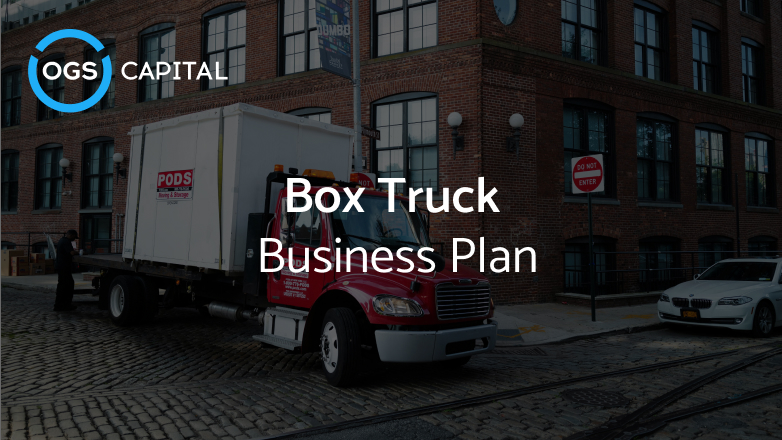Table of Content
What Is the Business Plan for a Box Truck?
A box truck is a vehicle with a cargo area enclosed on all sides and attached to a cab. A box truck business plan is a professional document that describes a business’s goals, strategies, and financial projections. A business plan like transportation business plan is essential for any entrepreneur who wants to start or grow a box truck business.
A new box truck business plan should include:
- Executive Summary
- Company Overview
- Industry Analysis
- Customer Analysis
- Competitive Analysis
- Marketing Plan
- Operations Plan
- Organization and Management
- Financial Plan
Why Do You Need a Business Plan Template for a Box Truck Company?
A box truck owner-operator business plan template helps you write your business plan faster and easier. A business plan for a box truck company can provide you with:
- Standard format and structure
- Research and analysis guide
- Sample business plan for 26ft box truck
- Checklist of essential elements
A business plan template like a logistics business plan can save time and effort. However, don’t rely solely on a transportation box truck business plan template. You should also:
- Customize the used box truck business plan to suit your business
- Conduct thorough research and analysis
- Use reliable data sources
- Regularly review and revise the plan
Here is a box truck business plan example for a box truck business called Box It Up:
Executive Summary
Box It Up is a Houston box truck company started up in 2023 by Jacob Lee. Jacob’s an experienced truck driver who drove for 10 years before launching his own company. Box It Up has 10 technologically advanced box trucks for quality and affordable box truck services.

Our mission at Box It Up is simple – we want to give Houston the best box truck services around. Our vision is to become Houston’s number one box truck company. What really sets us apart is our:
- Skilled and professional drivers, movers, and packers
- Modern and safe box trucks with advanced features
- Varied and tailored services for different customer needs
- Strong brand and reputation in the local market
- Partnerships with furniture and appliance stores
Box It Up expects to make $1.2 million in revenue and $300,000 in net profit in the first year, with a 25% annual growth rate. It will break even in 6 months. It needs $500,000 to buy 5 more box trucks, hire 10 more staff, and start a marketing campaign. It is looking for a loan from a local bank with a 10% interest rate and a 5-year repayment period. Our moving company business plan covers this in detail.
Company Overview
Jacob Lee owns a Houston moving company called Box It Up. With 10 years under his belt as a truck driver, he decided to start his own business. Now Lee runs a company that helps folks in the Houston area move furniture and appliances. You can find Box It Up at 123 Main Street, Houston, TX 77002.
Jacob founded Box It Up in 2023 with one box truck and two staff and grew it to 10 box trucks and 20 staff. It has done over 500 moves and deliveries and has many happy and loyal customers.
Box It Up offers a range of box truck services, including:
- Residential and commercial moving
- Furniture and appliance delivery
- Packing and unpacking
- Storage
Box It Up’s market is the Houston area, with over 7 million people and a high need for box truck services. Its customers are:
- Homeowners and renters
- Businesses and offices
- Furniture and appliance stores
- Anyone who needs to store their belongings
Industry Analysis
Immigration business plan
Trucking is a huge and varied industry here in the US. One part of it is the box truck business. Box trucks are an important piece of the larger trucking world.
According to the American Trucking Association, the US trucking industry generated over $940.8 billion in revenue and employed over 8.4 million people in 2022. Experts expect the trucking industry to grow at a compound annual growth rate (CAGR) of 3% from 2023 to 2027.
The box truck industry is a niche segment of the trucking industry that focuses on providing moving and delivery services.
A report by Verified Market Research values the box truck market size at $11.70 billion in the year 2021, expecting it to reach $17.34 billion in 2030, growing at a CAGR of 5.03% from 2023 to 2030.
The key drivers of the box truck industry, as highlighted in our food delivery business plan are:
- Increasing demand for moving and delivery services
- Rising disposable income and consumer spending
- Growing preference for convenience, flexibility, and reliability
- Technological advancements and innovations
- Favorable government policies and initiatives
The barriers of the box truck industry are:
- High capital and operating costs
- Intense competition and price pressure
- Regulatory and legal compliance issues and challenges
- Seasonal and cyclical fluctuations and uncertainties
- Shortage and turnover of qualified and skilled drivers, movers, and packers
Customer Analysis
Box It Up operates in Houston, providing box truck services. The company segments its target market into four main customer segments:
- Residential movers – Individuals or families relocating within or outside Houston. They account for about 40% of the company’s revenue.
- Commercial movers – Businesses or organizations moving to a new location. They account for about 20% of the company’s revenue.
- Furniture and appliance delivery – Customers who need to transport items from a store or warehouse to their location. They account for about 30% of the company’s revenue.
- Storage – Customers who need to store their belongings temporarily or long-term. They account for about 10% of the company’s revenue.
Some of the needs, preferences, and pain points of Box It Up’s customers are:
- Needs – Fast, reliable, and affordable box truck services that can transport their belongings safely and securely.
- Preferences – Easy to book and access flexible, customizable, professional, and courteous services.
- Pain points – Lack of availability and quality of services, high and variable costs, low and inconsistent customer service.
Competitive Analysis
Box It Up faces competition from both direct and indirect competitors in the Houston box truck market.
Direct Competitors
- U-Haul – Offers moving, delivery, storage, and towing services. Strengths are brand recognition and service diversity. Weaknesses are high prices and low customer satisfaction.
- Budget Truck Rental – Primarily offers moving and delivery services. Strengths are low prices and customer loyalty. Weaknesses are limited availability and service range.
- Penske Truck Rental – Primarily offers moving and delivery services. Strengths are high-quality vehicles and customer service. Weaknesses are high prices and a limited network.
Indirect Competitors
- Personal vehicles – Common for local or short-distance moves. Strengths are low cost and flexibility. Weaknesses are limited capacity and safety.
- Rental trucks – An option for moving large or heavy items. Strengths are availability and affordability. Weaknesses are responsibility and hassle.
- Public transit – An alternative for moving small or light items. Strengths are low cost and environmental friendliness. Weaknesses are unreliability and inflexibility.
- Online shopping – A substitute for buying and delivering items. Strengths are ease, speed, and variety. Weaknesses are quality, delivery, and return issues.
Box It Up’s competitive advantage and differentiation are:
- Fast, reliable, and affordable box truck services.
- Specialization in residential and commercial moves
- Large fleet of technologically advanced box trucks
- Strong network of contacts and strategic partnerships in the local market
Marketing Plan
Box It Up’s marketing objectives and goals are:
- Increase brand awareness in Houston
- Convert more leads into customers
- Retain and satisfy existing customers
- Achieve a 10% market share and a 20% profit margin
Box It Up’s marketing strategy and mix are:
- Product – Fast, reliable, and affordable box truck services
- Price – Value-based pricing with discounts for online, advance, or bulk bookings
- Place – Operate in the Houston metropolitan area with a central office and a fleet of 10 box trucks
- Promotion – Use a mix of online and offline channels
Marketing Budget: Box It Up’s marketing budget is 10% of revenue or $120,000 per month allocated as per the chart below:

Operations Plan
Box It Up’s operational structure consists of three departments:
- Administration
- Operations
- Marketing
Box It Up’s operational process consists of four main stages:
- Inquiry
- Booking
- Service
- Feedback
Box It Up’s operational resources include:
- Physical resources like office, warehouse, trucks, equipment
- Human resources like employees and contractors
- Financial resources like revenue, profit, cash flow
- Informational resources like website, customer data
Box It Up’s operational requirements are:
- Fixed costs
- Variable costs
- Startup costs
Box It Up’s operational standards include:
- Customer service standards
- Service delivery standards
- Safety and security standards
- Environmental and social standards
Box It Up’s operational policies include:
- Booking policy
- Cancellation policy
- Payment policy
- Refund policy
- Damage policy
- Liability policy
- Privacy and confidentiality policy
Box It Up’s operational risks are:
- Accidents and injuries
- Theft and vandalism
- Delay and cancellation
- Complaint and dispute
In short, Box It Up has a structured operational system with defined processes, resources, standards, policies, and risks. The focus is on customer service, safety, and continuous improvement.
Organization and Management
Box It Up is a sole proprietorship box truck business owned and operated by Jacob Lee.
Box It Up’s organizational structure consists of 3 levels:
Level 1 – Owner and Chief Driver, Jacob Lee.
Level 2 – Managers for administration, operations, and marketing.
Level 3 – Staff including drivers, movers, packers, accountant, lawyer, and marketer.
Box It Up’s ownership and legal structure are:
- Box It Up is a sole proprietorship owned and operated by Jacob Lee.
- Registered and licensed in Texas, with a USDOT number, an MC number, and a UCR registration.
- Has a HAZMAT registration, a HAZMAT permit, and a HAZMAT endorsement.
- Has liability, property, and cargo insurance, as well as an HVUT and Form 2290.
- Pays tax on net income, and sales tax and road tax on its box truck services.
Financial Plan
Box It Up’s financial assumptions and estimates are:
Financial Assumptions
- Revenue growth rate: 10% per year.
- Cost of goods sold (COGS): 40% of revenue.
- Operating expenses: 30% of revenue.
- Interest rate: 5% per year.
- Tax rate: 25% per year.
Financial Estimates
- Revenue: $100,000 per month, or $1.2 million per year.
- Gross profit: $60,000 per month, or $720,000 per year.
- Operating income: $30,000 per month, or $360,000 per year.
- Net income: $21,563 per month, or $259,750 per year.
- Assets: $350,000.
- Liabilities: $270,000.
- Equity: $80,000.
Projected Income Statement
| Year | 2024 | 2025 | 2026 |
| Revenue | $1,200,000 | $1,320,000 | $1,452,000 |
| COGS | $(480,000) | $(528,000) | $(580,800) |
| Gross Profit | $720,000 | $792,000 | $871,200 |
| Operating Expenses | $(360,000) | $(396,000) | $(435,600) |
| Operating Income | $360,000 | $396,000 | $435,600 |
| Interest Expense | $(15,000) | $(12,500) | $(10,000) |
| Pre-Tax Income | $345,000 | $383,500 | $425,600 |
| Taxes | $(86,250) | $(95,875) | $(106,400) |
| Net Income | $258,750 | $287,625 | $319,200 |
Projected Balance Sheet
| Year | 2024 | 2025 | 2026 |
| Assets | |||
| Cash | $50,750 | $100,000 | $110,000 |
| Accounts Receivable | $79,575 | $139,095 | $121,000 |
| Inventory | $50,000 | $55,000 | $60,500 |
| Other Current Assets | $50,000 | $55,000 | $60,500 |
| Total Current Assets | $250,750 | $299,575 | $381,095 |
| Property, Plant and Equipment | $300,000 | $300,000 | $300,000 |
| Less: Accumulated Depreciation | $(60,000) | $(90,000) | $(120,000) |
| Net Property, Plant and Equipment | $240,000 | $210,000 | $180,000 |
| Other Long-Term Assets | $50,000 | $55,000 | $60,500 |
| Total Assets | $540,750 | $564,575 | $621,595 |
| Liabilities and Equity | |||
| Accounts Payable | $100,000 | $110,000 | $121,000 |
| Accrued Expenses | $20,000 | $22,000 | $24,200 |
| Other Current Liabilities | $50,000 | $55,000 | $60,500 |
| Total Current Liabilities | $170,000 | $187,000 | $205,700 |
| Long-Term Debt | $250,000 | $200,000 | $150,000 |
| Total Liabilities | $420,000 | $387,000 | $355,700 |
| Share Capital | $100,000 | $100,000 | $100,000 |
| Retained Earnings | $20,750 | $77,575 | $165,895 |
| Total Equity | $120,750 | $177,575 | $265,895 |
| Total Liabilities and Equity | $540,750 | $564,575 | $621,595 |
Projected Cash Flow Statement
| Year | 2024 | 2025 | 2026 |
| Cash Flow from Operating Activities | |||
| Net Income | $258,750 | $287,625 | $319,200 |
| Adjustments for Non-Cash Items: | |||
| Depreciation | $30,000 | $30,000 | $30,000 |
| Changes in Working Capital: | |||
| Increase in Accounts Receivable | $(10,000) | $(11,000) | $(12,100) |
| Increase in Inventory | $(5,000) | $(5,500) | $(6,050) |
| Increase in Other Current Assets | $(5,000) | $(5,500) | $(6,050) |
| Increase in Accounts Payable | $10,000 | $11,000 | $12,100 |
| Increase in Accrued Expenses | $2,000 | $2,200 | $2,420 |
| Increase in Other Current Liabilities | $5,000 | $5,500 | $6,050 |
| Net Cash Provided by Operating Activities | $285,750 | $314,325 | $345,570 |
| Cash Flow from Investing Activities: | |||
| Purchase of Property, Plant and Equipment | $(30,000) | $(30,000) | $(30,000) |
| Purchase of Other Long-Term Assets | $(5,000) | $(5,500) | $(6,050) |
| Net Cash Used in Investing Activities | $(35,000) | $(35,500) | $(36,050) |
| Cash Flow from Financing Activities: | |||
| Repayment of Long-Term Debt | $(50,000) | $(50,000) | $(50,000) |
| Dividends Paid | $(200,000) | $(200,000) | $(200,000) |
| Net Cash Used in Financing Activities | $(250,000) | $(250,000) | $(250,000) |
| Net Increase in Cash | $750 | $28,825 | $59,520 |
| Cash at Beginning of Period | $50,000 | $50,750 | $79,575 |
| Cash at End of Period | $50,750 | $79,575 | $139,095 |
Great experience
My experience with Alex and his team has been excellent! Alex always responds to my emails and texts very quickly and is always accommodating. I look forward to creating a long-term relationship with him and his team. I highly recommend him.
OGSCapital for your Box Truck Business Plan
If you are looking for a professional and reliable business plan service, our business plan consultants at OGSCapital can help. We are a team of experienced and expert business plan writers with over 15 years of industry experience. We have helped thousands of clients from various industries and markets achieve their business goals and secure funding.
We can create customized and high-quality business plans for any purpose, like the drop shipping business plan or HotShot business plan. We also offer additional services, such as market research, financial analysis, pitch deck creation, and more, to help you succeed in your business venture. Contact us today to discuss further!
Frequently Asked Questions
How profitable is owning a box truck?
Owning a box truck in the US is profitable, as the average annual revenue for box truck owners is $112,000. However, the profitability may vary depending on various internal and external factors.
How do I start a box truck business from scratch?
To start a box truck business from scratch in the US, you need to follow these steps – Do your research, select your services, check local legal requirements, obtain permits and licenses, apply for an EIN, register your business with your state, get credentials from the FMCA, buy or lease a box truck, get insurance, find customers, market your business, and manage your finances.
Download Box Truck Business Plan Template in PDF
OGSCapital’s team has assisted thousands of entrepreneurs with top-rate business plan development, consultancy and analysis. They’ve helped thousands of SME owners secure more than $1.5 billion in funding, and they can do the same for you.



















